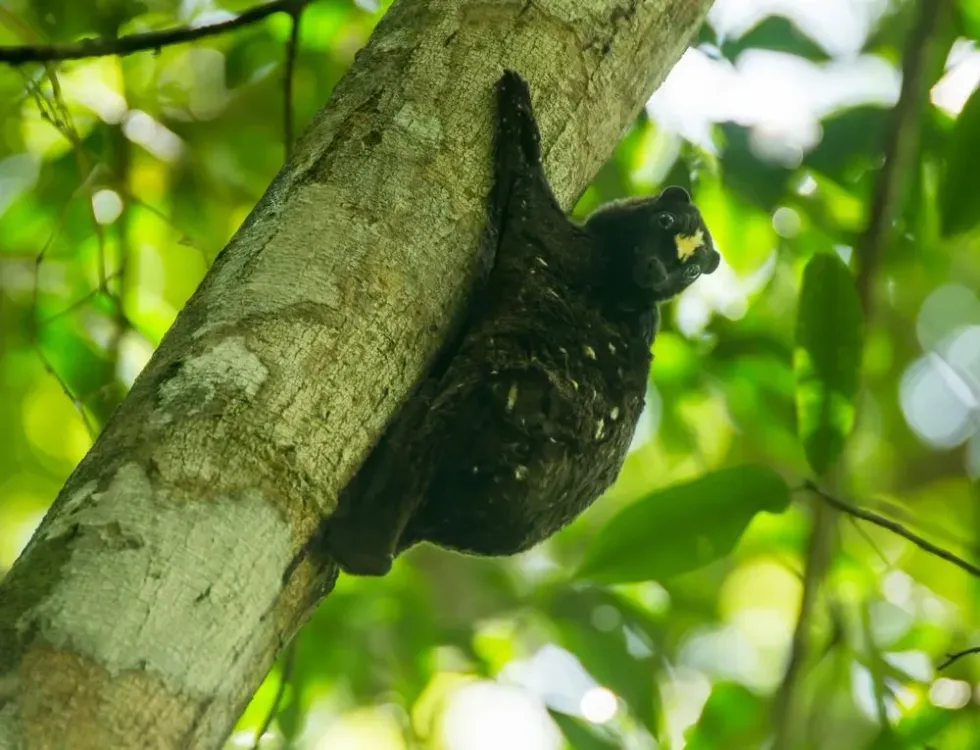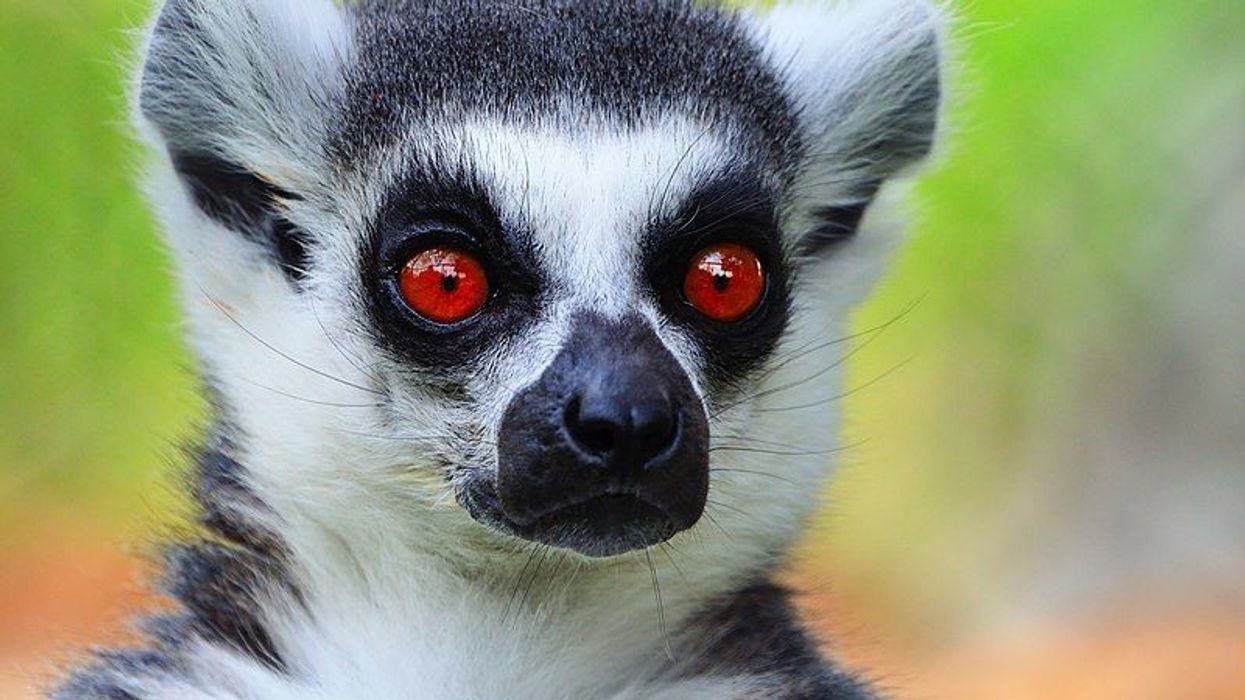The Philippine flying lemur (Cynocephalus volans) belongs to the family Cynocephalidae and order Dermoptera. This species is endemic to the southern Philippines.
The range of this species includes the islands of Basilan, Mindanao, Samar, Leyte, and Bohol. The Philippine flying lemur habitat consists of forested areas, lowlands, and occasionally coconut and rubber plantations.
The breeding or mating of the Philippine flying lemur species takes place from January to March. The gestation period of the Philippine flying lemur is two months long.
After the gestation period, one young or twins is born. The Philippine flying lemur baby or offspring is known to be carried by the mother on its belly.
It reaches sexual maturity at the age of two or three.
The Philippine flying lemur is brownish-gray and white in color, which helps them camouflage well. It has a blunt muzzle and short ears and its eyes are huge, and the head is wide or broad.
The limbs are of equal size and have a distinct structure called a patagium. The diet or food of the Philippine flying lemur (Cynocephalus volans) consists of or is known to eat fruits that are soft, young leaves, insects, and flowers.
This species is known to be clumsy on land or the forest floor and is known for its skillful climbing ability and is known to spend most of its time on trees and feed upside down, and cannot fly. In some plantations, these are considered pests.
This species is not endangered. It is quite interesting to learn about the Philippine flying lemur and its features and behavior and if you are interested, read about gerbil and numbat too.
Philippine Flying Lemur Interesting Facts
What type of animal is a Philippine flying lemur?
Philippine flying lemur is a colugo.
What class of animal does a Philippine flying lemur belong to?
It belongs to the class of mammals.
How many Philippine flying lemurs are there in the world?
There is no exact number or count of the population of these lemurs in the world recorded or estimated.
Where does a Philippine flying lemur live?
This colugo is endemic to the southern Philippines and nearby islands. The population of this lemur is known to be distributed in the islands of Basilan, Mindanao, Samar, Leyte, and Bohol.
What is a Philippine flying lemur's habitat?
The habitat of this lemur includes extremely forested areas; it inhabits trees in mountainous forests and lowlands. It can also be spotted in coconut or rubber plantations. This colugo prefers to spend most of its time on the top of rainforest canopy or canopies.
Who do Philippine flying lemurs live with?
These animals tend to live alone, but several can be spotted in the same tree.
How long does a Philippine flying lemur live?
The exact lifespan of these animals is unknown, but the oldest living has been recorded to live for about 17.5 years in captivity.
How do they reproduce?
Not a lot of information is available about the reproduction of these colugos, but it has been recorded or observed that mating or breeding usually takes place between January and March. The gestation period lasts for about two months.
Birth is given to a single young or offspring, and sometimes, twins are born. The newborns or young ones are altricial, and the mother carries the baby or the young one on its belly.
Weaning takes place at six months of age. Sexual maturity is reached at the age of two or three.
What is their conservation status?
The Philippine flying lemur is known to be placed under the Least Concern category.
Philippine Flying Lemur Fun Facts
What do Philippine flying lemurs look like?

Sexual Dimorphism occurs in this species, and females are known to be larger than males. The coloration of the fur is known to be dark and is usually less spotted or speckled.
The head of these colugos is known to be wide or broad, just like a greyhound. They have short and round ears and a muzzle that is blunt.
The eyes of these colugos are known to be large eyes. The limbs tend to be of equal length, and they have sharp and short claws for climbing trees. The webs of skin are known to connect the toes.
This webbed skin is known to extend into a different structure that is called a patagium. It stretches or extends from the side of the neck to the fingertips, toes, and tail tip.
These colugos are known to have incisor teeth, just like cattle and deer. The plumage of the colugos is brownish-gray and white.
How cute are they?
This animal is considered cute because of its unique body structure.
How do they communicate?
Not much information is available regarding the communication of this lemur, but it is believed that this animal uses tactile and chemical cues to communicate with each other.
How big is a Philippine flying lemur?
The length of the Philippine flying lemur is around 6.7-15 in (17-38 cm). They are known to be of similar size as a cat.
How fast can a Philippine flying lemur move?
The exact speed of this species of flying lemur is unknown.
How much does a Philippine flying lemur weigh?
The weight of this flying lemur ranges from 2.2-3.7 lb (1-1.7 kg).
What are the male and female names of the species?
There are no specific names for males and females of this species.
What would you call a baby Philippine flying lemur?
There is no particular name for a baby of this species.
What do they eat?
The diet or food of these animals consists of young leaves and fruit, which are soft, insects, flowers, fruit shoots. Flowers that are eaten might include durian and coconut flowers.
They are also known to lick wet leaves for water. This animal is known to not eat on the forest floor and eat from trees in the canopy directly by gliding and jumping. Their main predator is the Philippine eagle, and they're also often hunted by humans.
Are they loud?
These animals are known to defend their territories with loud calls.
Would they make a good pet?
No, these flying lemurs will not make great pets as they are adapted to live and be in the treetops in tropical habitats or rainforests.
Did you know...
The name of this flying lemur is quite misleading as it cannot fly and instead glides.
These colugos are known to not swim.
The behavior of colugo, that is, Cynocephalus volans, is crepuscular.
The flying lemur is known to be very slow and lacks the capability of standing erect. It also is known to be very skillful when climbing trees and not very good on the forest floor or ground and thus, is considered arboreal.
When on trees, this arboreal mammal moves and feeds upside down.
This flying lemur is known to use their specialized teeth and tongue to pick leaves, and it is known to pick leaves in a similar manner to a cow.
Plantation owners consider this species as a pest as it feeds on fruits, flowers, and leaves.
Some people tend to hunt this species for its meat.
The conservation of this species of order Dermoptera because of its morphologically, ecologically, and phylogenetically uniqueness or distinction is considered important, and thus, it has been stated that it is important to make efforts to conserve this species to reassess and also in terms of some recent discoveries which have the probability of categorizing new species are that genetically and morphologically distinct or different.
The Philippine flying lemur genus consists of one other member, that is, Sunda flying lemur.
This species is considered ecologically important as it engages in seed dispersal.
One of the evolutionary studies has stated that the colugos are the closest living primate relatives.
A group of Philippine flying lemurs is called a troop.
Why are Philippine flying lemurs endangered?
This species of flying lemur is not endangered, but they are known to be affected by the loss of habitat through deforestation.
How did Philippine flying lemurs get their name?
Not much information is about how the flying lemur got its name.
Here at Kidadl, we have carefully created lots of interesting family-friendly animal facts for everyone to discover! For more relatable content, check out these paca facts and gopher facts pages.
You can even occupy yourself at home by coloring in one of our Philippine Flying Lemur coloring pages.









